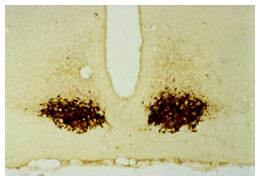1) |
Clarification
of clock machinery to generate TIME |
|
1.1 Identification
of ALL components of CLOCK |
|
We try to isolate all parts
of transcription-translation machinery. We
focus SCN since all components of the SCN is
specialized to generate TIME. From the point
of the functional specialization of BRAIN,
and from the general rule that CELL expresses
a limited number of genes to play specific
physiological role, SCN must be rich in expressing
TIME-related genes. In this project we will
isolate ALL genes expressed in SCN by in situ
hybridization. Then, we will perform gene targeting
to these SCN-expressing genes. |
|
1.2 Identification
of PER associating proteins (PAS) and transcription-translation
feedback loop of clock genes |
|
To explain the generation
of cyclic TIME, transcription & translation
feedback loop of clock genes is hypothesized.
This theory is supported by the number of molecular
and genetic studies of clock genes. However,
the precise mechanism of transcription initiation
and suppression is far from understanding.
We will clarify this by the whole description
of molecular clock components. Per1 & Per2
genes will have the key role for robustness
of oscillation. It is known that PER1 & PER2
proteins form huge molecular complex. Thus,
we will isolate the all components of PER associating
proteins (PAS), and clarify the transcription
and translation feedback loop of clock genes. |
|
1.3 Clock genes and
cell metabolism, birth, and death |
|
Why virtually all cells in
the body have the clock oscillating system
inside the cell? We will identify how clock
genes work on the energy metabolism, cell cycles,
and cell death. |
|
|
2) |
Intercellular system for
synchronizing TIME |
|
2.1 Region-specific
knockdown of SCN |
|
SCN biological clock is composed
of thousands of clock cells which are subdivided
into several groups. We will perform region-specific
knockdown of these subdivisions to address
the functional subdivision of SCN. |
|
2.3 Geography of
SCN |
|
SCN clock cells are highly
organized in time and space. For example, in
our real-time luciferase-imaging system at
cell level, time is generated and synchronized
in a very highly organized system. We will
complete and theorize the time-space geography
of the SCN. |
|
|
3) |
Symphony of TIME in individuals |
|
3.1 SCN-adrenal pathway:
conversion of time signals from nerve impulse
to hormones |
|
Standard time produced in
the SCN is released strongly via central and
peripheral autonomic nervous system. Sympathetic
nerve impulses are conducted to the adrenal
gland and converted to the endocrine signals
by unknown mechanism. We will clarify what
is happening in the adrenal gland. |
|
3.2 Glucocorticoid
is the mediators of central time |
|
Glucocorticoid is a mediator
of TIME. We will clarify the molecular mechanism
how glucocorticoid regulates the peripheral
clocks. |
|
3.3 Timing system
outside the SCN |
|
In some environmental conditions
such as restriction feeding, extra-SCN region
sometimes generates SCN-independent rhythm.
We will clarify the system from its molecular
level. |
| |
 VIP
cells in the SCN (1983). VIP
cells in the SCN (1983).
VIP cells formed the
paired clusters
just above the SCN.
|

